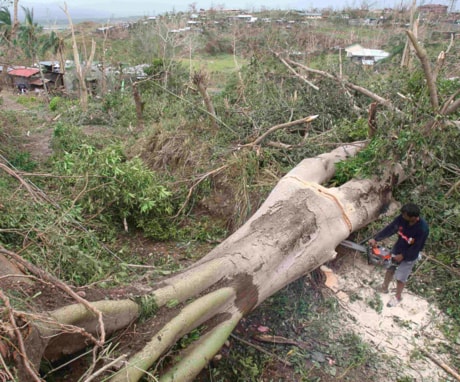CAUAYAN, Philippines — A super typhoon that killed 13 people and flattened forests and crops in the northern Philippines dumped heavy rains on the capital Tuesday as it headed across the sea toward southern China.
Typhoon Megi struck the Philippines on Monday with ferocious winds of 140 miles (225 kilometres) per hour, but initial assessments showed relatively light damage and casualties, partly because the storm struck sparsely populated areas. Philippine officials also cited their massive emergency preparations days ahead of the storm.
Food vendor Nesie Callaotit, her husband and two children were hurriedly packing clothes to flee to safety when the wind yanked off half of their tin roof, exposing their house in northeastern Isabela province to pounding rain and the horrifying wind.
They held on to a wooden post for three hours, weeping and praying together, until the torrents eased.
“All of us were in tears,” the 40-year-old Callaotit said. “We thought it was our last day together.”
After it exited into the South China Sea on Tuesday, Megi was almost stationary packing winds of 108 mph (175 kph) but was forecast to regain strength before its expected landfall in southern China on Thursday. Chinese authorities evacuated 140,000 people from a coastal province.
Isabela province in the northeast Philippines, Megi’s entry point, bore the brunt of the Typhoon Megi’s destruction while more than 8,000 people rode out the typhoon in sturdy school buildings, town halls, churches and relatives’ homes.
Roads in and out of the coastal province were deserted and blocked by collapsed trees, power lines and debris.
Iron-sheet roofs on many of the houses were blown away. In Tamauini town, Ariel Marzan said he escaped just minutes before his house tumbled amid winds so strong his roof was swept into a nearby rice field 30 yards (meters) away.
“I didn’t expect it to be so strong,” he said as he surveyed the damage and picked up the strewn pieces of his household.
Nearby coconut and banana groves were flattened.
At least 13 deaths in Cagayan, Isabela and Pangasinan provinces were blamed on the typhoon, including at least six drownings. In Pangasinan province, a mother, her daughter and son were pinned to death when a tree collapsed on their house, disaster official Eugene Cabrera said.
Even as the typhoon moved away, its massive outer bands still stretched over much of western Luzon and drenched the capital, Manila, and surrounding areas, snarling traffic and sending about 1,000 people out of their homes into temporary shelters.
President Benigno Aquino III said Tuesday that although the typhoon caused significant damage, the loss of life was minimal and “could have been much greater had we not prepared for the storm.”
“The work of bringing life back to normal in the soonest possible time is already under way,” he said.
Assistant Agriculture Secretary Salvador Salacup said an initial estimate of $36 million losses to rice and corn crops showed the damage was minimal. Cagayan Valley and Ilocos regions lost around 12 per cent of their rice production for the season. Cagayan Valley alone accounts for 30 per cent of the national rice output.
Typhoon Megi is likely to spare Vietnam, which was in early forecast paths and has been suffering severe flooding in the past week. At least 41 flood-related deaths have been reported, and 19 other people are presumed dead after a bus was swept off a road by raging currents.
Up to 31.5 inches (800 millimeters) of rain pounded areas of Vietnam in just a few days, forcing 126,000 people to flee their homes. Earlier flooding this month left more than 80 people dead or missing.
The death toll from recent flooding in Thailand rose to five on Tuesday. Downpours that started over the weekend have affected nearly 55,000 people in 17 central and northeastern provinces, according to the Disaster Prevention and Mitigation Department.
